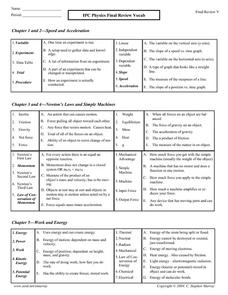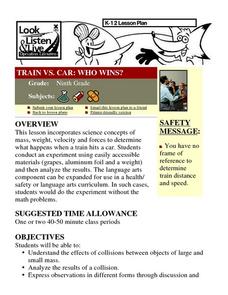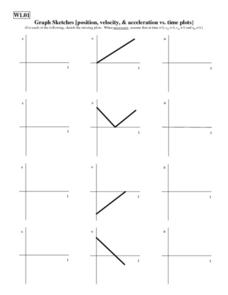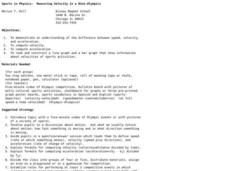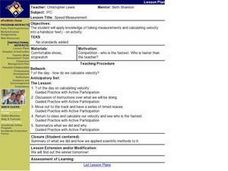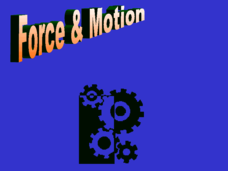Curated OER
IPC Physics Vocabulary Review
In this physics review instructional activity, students review vocabulary words associated with speed, acceleration, Newton's Laws and simple machines, work and energy, magnetism, electricity, and harmonic motion and light. This...
Curated OER
Acceleration, Drag, Gravity, Motion, Forces, and Friction
Eighth graders build and run mousetrap cars in order to measure distance, time, and mass for their cars. They use these measurements to calculate average speed and kinetic energy, then create a slide show to visually explain how the car...
Curated OER
Let's Get Moving
Students participate in sports activities that relate to motion, velocity and momentum. They produce a PowerPoint presentation after researching the activities.
Curated OER
Train vs. Car: Who Wins?
Ninth graders conduct an experiment demonstrating what happens when a train hits a car using easily accessible materials. They calculate momentum, velocity, and distance using the appropriate formulas. Then they write an incident report...
Curated OER
Graph Sketches
In this graphing activity, learners use velocity vs. time graphs to create speed vs. time and acceleration vs. time graphs. Students create 24 graphs.
Curated OER
Motion Crossword Puzzle
In this motion activity, students complete a crossword puzzle given 11 clues related to rate, acceleration, force of gravity and velocity. They also complete a puzzle where they unscramble 11 words related to motion to solve for a final...
Curated OER
Roller Coaster Physics
Students design a roller coaster that allows a marble to run the course as fast as possible. Students create an experimental roller coaster taking into account the steepness of the hills and the sharpness of the turns. Students use a...
Curated OER
Regents High School Examination PHYSICAL SETTING PHYSICS 2003
In this chemistry exam, physics pupils complete a series of multiple choice and short answer questions by completing calculations on speed, velocity, magnitude and inertia.
CK-12 Foundation
Water Fountain
Most water fountains are designed to keep the water inside the fountain, but how are they designed to shoot up and out without the water leaving the fountain? Scholars vary the launch angle, fountain height, launch speed, and catcher...
CK-12 Foundation
Newton's Cannon
Gravity does more than keep our feet on the ground — it holds a satellite in orbit, too. Help learners understand the effects of gravity on an orbiting object through a simulation activity. Individuals adjust a launch speed and watch as...
Curated OER
Review of Kinematics
In this kinematics review worksheet, learners complete 50 multiple choice questions on average speed, velocity and acceleration.
Curated OER
2009 Momentum 4
In this momentum activity, students solve 11 problems including finding initial and final momentum of objects, finding velocity of objects, determining kinetic energy before and after collisions and finding final speeds of moving objects.
Curated OER
Physical Setting: Physics Exam 2004
Twelve pages of mostly multiple-choice questions comprise this comprehensive New York Regents physics exam. It covers an entire year's worth of physics curriculum and requires about three hours for completion. Review the questions to...
Curated OER
Acceleration
The mechanics of rollercoasters, and the acceleration and velocities reached with the different kinds, are outlined in this presentation. Although short, this would be a great starter for a class working with building rollercoasters or...
Rice University
College Physics for AP® Courses
Take a look at an organized physics course. The 34-section electronic textbook covers material in AP® Physics 1 and 2. Teachers use the text to supplement lectures and have the class work through the labs. Each section contains multiple...
Curated OER
The UPS Experiment
Students calculate the speed using metric measurements. In this geometry lesson, students calculate speed, distance and velocity using metric measurements. They gain inquiry and problem solving skills in this assignment.
Curated OER
Science: Vectors
Students solve vector problems and identify the x and y coordinates. They determine if the coordinates are positive, negative, or zero. Students solve problems and convert the x and y coordinates to magnitude and direction.
Curated OER
Sports in Physics: Measuring Velocity in a Mini-Olympics
Eighth graders examine the difference between speed, velocity and acceleration. In this velocity lesson students read and construct a line graph and a bar graph to show information about velocities of sports activities.
Curated OER
Speed Measurement
Learners are asked how do they calculate velocity? They take a trip to the school's track and have a series of timed races. Students return to class and calculate their velocity and see who is the fastest. They summarize what they did...
Curated OER
Tracking Speed
Students collect data for a runner by measuring the time it takes for the runner to run equal distances. After collecting data, students average speeds and accelerations for the runner. Assignment is completed by graphing the data.
Curated OER
Force and Motion
Each of the slides here gives a definition, equation, or calculation example for a component of force and motion. This large collection covers topics from momentum and Newton's laws to centripetal forces and simple machines. Animations...
Curated OER
Typical Numeric Questions for Physics I - Momentum
Simple momentum computations and more complex collision computations can be found on these two worksheets. All of them can be answered by choosing from five possibilities. The first worksheet contains nine problems to solve, while the...
Curated OER
Typical Numeric Questions for Physics I - Waves
Physics masters figure out the wavelength of different waves. Looking at a wave graph, they identify different characteristics. Many more problems get them working with both electromagnetic and sound waves. There are a total of 17...
Friends of Fort McHenry
Cannons During the War of 1812
During the Battle of Baltimore in the War of 1812, only 25% of the bombs and rockets fired at Fort McHenry actually reached their target. Using an interactive online simulation, combine your historical study with physics and discover why...


